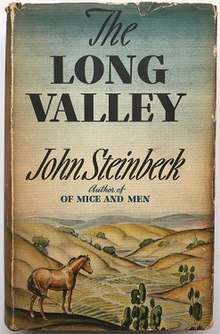The Long Valley
The Long Valley is a collection of short stories written by the American author John Steinbeck. The collection was first published in 1938.[1] It comprises 12 short stories.
 First edition | |
| Author | John Steinbeck |
|---|---|
| Country | United States |
| Language | English |
| Genre | Short story collection |
| Publisher | Viking Press |
Publication date | 1938 |
| Media type | Print (hardback & paperback) |
The short stories were written over several years and are set in Steinbeck's birthplace, the Salinas Valley in California. They include the prize-winning tale The Murder; The Chrysanthemums; the representation of lynch mob violence in The Vigilante, inspired by the lynching of the confessed murderers of Brooke Hart; and the classic Red Pony tales. Many of the stories were published previously. The Red Pony was written in 1933 and published in Reader's Digest.[2]
Stories
- "The Chrysanthemums"
- "The White Quail"
- "Flight"
- "The Snake"
- "Breakfast"
- "The Raid"
- "The Harness"
- "The Vigilante"
- "Johnny Bear"
- "The Red Pony"
- "The Murder"
- "Saint Katy the Virgin"
gollark: Checking Google translate...
gollark: 2 txzvs.
gollark: You can find meaning in any code with effort.
gollark: No, just yellow/red.
gollark: Now I just need yellow, red and some other one for my evil plan.
References
- The Long Valley, Western Washington University, Accessed November 2007
- Introduction to John Steinbeck, The Long Valley, John Timmerman, Penguin Publishing, 1995
Further reading
- Busch, Christopher S. "Longing for the Lost Frontier: Steinbeck's Vision of Cultural Decline in 'The White Quail' and 'The Chrysanthemums'." Steinbeck Quarterly 26.03-04 (Summer/Fall 1993): 81-90.
- Pellow, C. Kenneth. "'The Chrysanthemums' Revisited." Steinbeck Quarterly 22.01-02 (Winter/Spring 1989): 8-16.
- Renner, Stanley. "Mary Teller and Sue Bridehead: Birds of a Feather in 'The White Quail' and Jude the Obscure." Steinbeck Quarterly 18.01-02 (Winter/Spring 1985): 35-45.
- Renner, Stanley. "Sexual Idealism and Violence in 'The White Quail'." Steinbeck Quarterly 17.03-04 (Summer/Fall 1985): 76-87.
- Ware, Elaine. "Struggle for Survival: Parallel Theme and Techniques in Steinbeck's 'Flight' and Norris's 'McTeague'." Steinbeck Quarterly 21.03-04 (Summer/Fall 1988): 96-103.
- Kohzadi, Hamedreza. "The Marriage of Hysteria and Feminism in John Steinbeck's The Chrysanthemums: Elisa Allen as a Married but Virgin Feminist Homosexual Hysteric." Interdisciplinary Literary Studies 20.4 (2018): 429-469. https://www.jstor.org/stable/10.5325/intelitestud.20.4.0429
External links
This article is issued from Wikipedia. The text is licensed under Creative Commons - Attribution - Sharealike. Additional terms may apply for the media files.